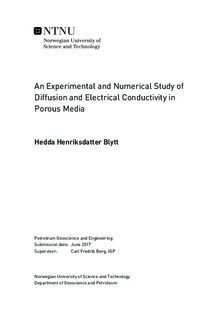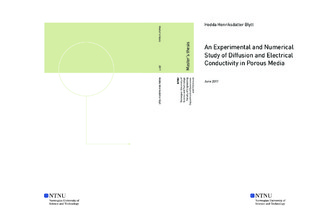| dc.description.abstract | In this Thesis the effective diffusion coefficient, the diffusibility and the formation factor in a porous medium are studied by preforming a diffusion experiment and electrical conductivity measurements. The main purpose is to compare the formation factor calculated from an electrical resistivity measurement with the reciprocal diffusibility estimated from diffusion experiments.
There is clearly an analogy between the diffusion of molecules and the electrical conductivity in the fluid phase of porous medium. Both equations are dependent on the same parameters, so the diffusibility and the formation factor calculated from these experiments should in theory be equal, when we disregard the excess of conductivity outside the water phase.
Almost all kind of siliclastic formations contain a certain amount of clay minerals, and clay minerals are conductive, though rocks usually are non-conductors.
When there are clay minerals present in a formation it will increase the conductivity, because there will be more paths for the electrical charged ions to pass through than just in the pure pore space of the rock. On the contrary a diffusion process of molecules can only happen in the pore space of the rock.
When clays are present in a formation, this will decrease the resistivity readings and reduce the formation factor. When resistivity logs are used to estimate the hydrocarbon content, it is essential to distinguish brine conductance from clay conductance.
The resistivity measurement is preformed by using a standard resistivity apparatus, while the diffusion experiment is custom made. The diffusibility and the effective diffusion coefficient from the diffusion experiments are found by matching the experimental data with numerical simulations. The difference between the reciprocal diffusibility and the formation factor should correspond to the increased conductance due to the presence of clay. The purpose of this work is to try to show that the formation factor calculated from resistivity measurement is lower than the formation factor estimated from diffusion, unfortunately the results unexpected. | |

